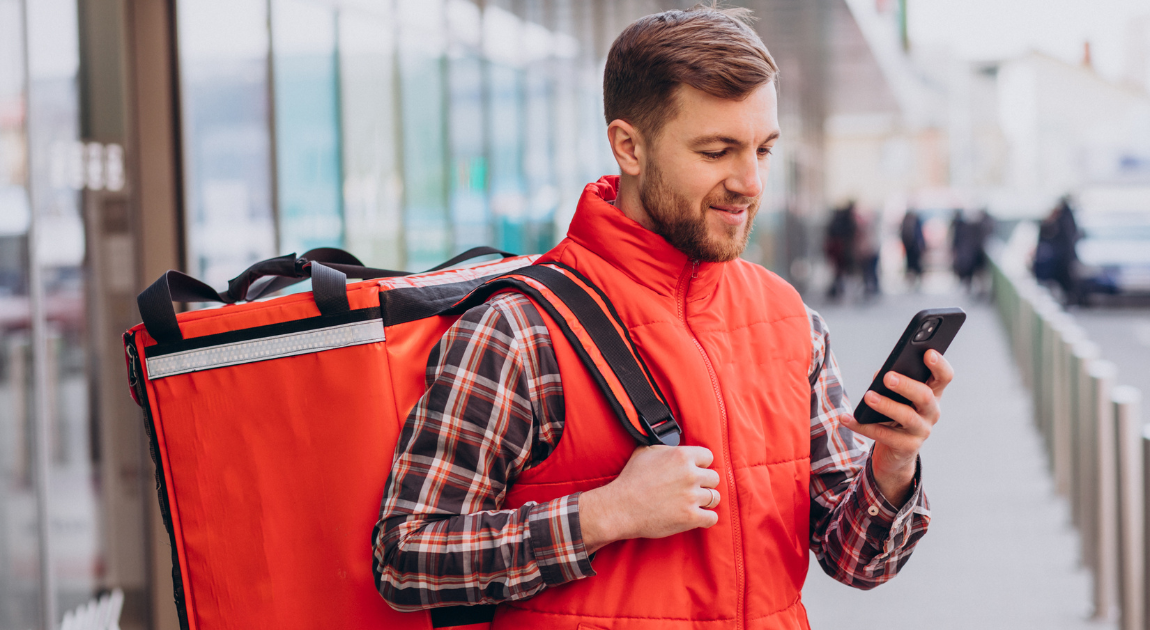On-demand pickup and delivery apps are no longer just for food — they’re transforming industries from retail and logistics to healthcare and home services. But how much does it actually cost to build one of these powerful platforms? The answer depends on your goals, features, tech stack, and more. In this article, we break down the types of pickup and delivery apps, their key components, and the full development process — with real-world cost estimates and tips to help you build a scalable, efficient solution that fits your business. Let’s dive in.
What are pickup and delivery apps?
Pickup and delivery apps are digital platforms that allow users to request, schedule and manage the transportation of goods. The classic, archetypal example is, of course, that of a food delivery app (and it is, in fact, still one of the dominant “genres”) but today, these apps support a wide range of industries, as well, from eCommerce to parcel services, dry cleaning, and even heavy freight.
This proliferation of best practices is, after all, understandable: the urgency of food delivery pushed businesses to adopt fast, predictable, and convenient ways to fulfill orders. By 2024, the on-demand delivery services market (including non-food delivery) had already reached an estimated $166.7 billion globally, with projections to surpass $310 billion by 2029. Now the accumulated expertise is used to streamline last-mile logistics, with real-time tracking and reduced customer support burden being near-universal benefits.
What does a complete pickup and delivery app solution look like?
Now, contrary to what the name may imply, in many cases, the entire solution will include more than just the iOS or Android app, since in the delivery process, there are at least three parties: the customer, the delivery team, and the back office. So there are three key components:
- A customer-facing app, where end users place and manage orders, now typically including order tracking, in-app payments, and notifications. This part is also the one that’s most heavily focused on UX and branding.
- Courier-side app for drivers and agents. This one may or may not be the same as the customer-facing one (if it is, then the resulting application needs more user roles). The main functionalities are task notifications, route optimization, proof of delivery related features, and status updates, preferably with offline functionality available.
- Admin dashboard for back office, with analytics, customer support tools, and integrations to ERP, CRM, or other systems like WMS.
Building all three is an especially good idea when there’s need for end-to-end control over processes, with higher order volumes, or when some aspects of the workflow require regulatory compliance on top of just operational efficiency. Technologically, it is then possible to scale each of the components more or less independently, since the tech stacks used for these modularized parts are different – from React Native or Flutter for apps to React ar Angular for the dashboards, and .NET on the backend (plus, of course, the cloud tech and DB management).
Types of pickup and delivery applications by industry
While the core functionality of pickup and delivery apps—scheduling, real-time tracking, and communication—remains consistent, their implementation varies significantly across industries. These differences impact both the tech stack and how the app is designed, integrated, and scaled.
- Food and grocery delivery apps in the vein of Uber Eats and such are busily for high-frequency orders and (often) perishable goods, so they focus on rapid location-based tracking, dynamic ETA updates, and route optimization. More recent additions to the functionality sets include multi-restaurant support, customer ratings, and delivery zone based logic.
- Parcel and courier delivery apps (the likes of DHL and FedEx) focus more on document validation, label generation, barcode scanning, route batching etc. Popular features include multi-stop scheduling, chain-of-custody logging, driver dashboards, and ERP integrations.
- Service and local tasks apps (like GoShare) are the most diverse group, most commonly dealing with pickup and delivery of bulky items like furniture – but also with services. They prioritize driver scheduling, capacity-based matching, and real-time chat. Key tech possibilities include geo matching logic, and load photo uploading.
- Healthcare and pharmacy delivery apps are the most regulated ones (HIPAA, GDPR), with a heavy emphasis on security and chain-of-custody. To these ends, they use e2e encryption, audit trails, ID verification, delivery consent forms and more.
Needless to say, within each of these groups, the actual business needs will further dictate what other features and technologies to implement in each separate case. Even food delivery apps are not as basic and uniform as they seem: it’s one thing to operate in a densely populated urban area with plenty of competitors, and quite another, to run delivery in a sprawling, vast locale where your competitor is one’s own kitchen or a local factory canteen.
Key features (and impact on costs)
The choice of features for a pickup/delivery app is not just important for how well it will solve challenges in its intended setting, but also because it influences the total cost of development. This may not be obvious with a basic MVP that only has the core functionalities, but once you’ve begun to actually scale it, there needs to be a balance between the features and the ROI. Here are some of the most critical features to think of:
Real-time GPS tracking
One of the most demanded features, GPS tracking allows customers to monitor delivery status and helps couriers optimize their routes. Implementing this feature requires integration with mapping APIs (like Google Maps or Mapbox), geolocation services, and background tracking, which can significantly increase backend complexity and cloud usage, raising development and infrastructure costs.
Scheduling and time slot selection
Letting users choose delivery/pickup times is a key differentiator in many sectors like laundry, grocery, or courier services. Implementing this feature requires calendar integration, logic for time slot availability, and sometimes coordination with courier scheduling tools — adding both frontend and backend workload.
Multi-user roles and authentication
Developing secure login and profile systems for customers, couriers, and admins (often with different interfaces and permissions) adds layers of development. This usually includes social login options, OTP verification, and password recovery—all increasing the complexity of the user management system.
In-app payments and order management
Integrating with payment gateways (Stripe, PayPal, Square) requires secure tokenization, transaction tracking, and sometimes compliance with PCI DSS standards. Order management systems, especially with real-time status updates, require additional workflows, notification logic, and database structuring.
Push notifications and alerts
Push notifications improve customer engagement and reduce support queries. Setting up a reliable notification system (via Firebase or OneSignal) for different triggers (order accepted, courier arrived, etc.) adds several development hours, particularly for segmented and scheduled messaging.
Ratings and feedback
To support quality control and transparency, apps often include courier and service reviews. This requires UI design for feedback screens, backend logic for storing and processing reviews, and sometimes moderation tools in the admin dashboard.
How much does it cost to build a pickup & delivery app?
It’s not just the features and functionalities that define the app cost, though: there are several factors, like the development team, level of specialization, platform choice, and more. On average, when all of these are taken account of, the development of a full-fledged pickup and delivery app solution (with dashboards and everything) will range between $400,000 and $250,000.
One of the factors that contribute to the range is the location of the team if you offshore the job. In North America, with hourly rates of roughly $100-ish per hour, the full app would likely cost around $150k-$250k. Western Europe averages at $100k-$200k, while Eastern Europe is the traditional “Goldilocks zone” between that and South Asia, at about $35-$90 per hour, and a full app at about $500k-$150k.
Another factor is the choice of platform. Native development specifically for iOS and Android usually adds around 40% in cost, but in practice, delivery apps don’t often need the super specialized device features, so many go with cross-platform approaches (especially Flutter and React Native).
Backend infrastructure is also important, since aloud hosting on AWS or Google Cloud will add to the ongoing costs, as third-party APIs also would.
Finally, there’s design, which varies in costs depending on the level of customization you want. In many cases, infusing everything with idiosyncratic brand identity is a considerable but easily returned investment.
Overall, it’s always a good idea to work with a team that has enough industry expertise to point out the most sensible ways to achieve this or that result (instead of just selling the generic trends). This is how Lionwood.software ensures that the prices of solutions for our target industries don’t break the roof – if you’ve worked long enough with a certain industry, you can balance out the tech implementation with business needs so that you achieve more with less, and can always build on that in the long run.
Benefits
Pickup and delivery apps offer significant advantages for both businesses and consumers, driving growth and enhancing customer satisfaction.
- Enhanced customer spending and convenience. These apps streamline the ordering process, leading to increased consumer spending. For instance, customers who opt for delivery typically spend 20% more compared to those who pick up their orders . The convenience of ordering from home and the ability to track deliveries in real-time contribute to this increased expenditure.
- Market growth and adoption. The on-demand delivery market is experiencing rapid growth. The global last-mile delivery market size was valued at USD 143.8 billion in 2021 and is expected to generate USD 428.9 billion by 203. This surge is driven by the rising demand for convenience and the proliferation of mobile apps facilitating easy access to delivery services.
- Operational efficiency for businesses. For businesses, these apps enhance operational efficiency by optimizing delivery routes and reducing manual errors. Real-time tracking provides transparency and enhances customer satisfaction by offering accurate delivery times, reducing stress about the delivery process . This not only improves customer trust but also allows businesses to monitor and improve their delivery performance continuously.
Why go custom?
On the one hand, for the more generic type of delivery apps, there are now convenient off-the-shelf and white-label solutions that encapsulate quite a lot of the best practices from the past decade. On the other hand, there are multiple cases when custom development is simply necessary.
One is when brand identity goes far beyond graphic representation and into the realm of operationally endorsed brand promise. Things like same-day delivery, multi-location fulfillment, or niche offerings will very likely require not just their own idiosyncratic set of features, but also the possibility for the company to control more. What does the order flow look like? What integrations are needed? What pricing models are technologically possible?
Another consideration is scalability and flexibility – that is, how well the evolution of your app gets along with the growth of the business. Finally, regulated industries will also need something more than the standard blueprint of an app. In many competitive markets, this strategic advantage can make all the difference—especially when personalized service, backend automation, or analytics are essential to success.
Pickup and delivery app development process (with costs breakdown)
Up until this point, these were the general considerations about the cost of a pickup and delivery app; but what’s under the hood? Building a pickup and delivery app involves several phases, each with distinct deliverables, timeframes, and cost implications. Whether you’re developing a simple on-demand courier service or a feature-rich multi-industry platform, understanding the development process helps you plan strategically and control your budget.
#1 Discovery & planning
This initial stage is sometimes quite unwisely skipped, but it can potentially save fortunes in the long run. Product discovery involves business analysis, competitor research, technical feasibility assessments, and creating a product roadmap. The name of the game is to clarify app requirements, define user flows (for customers, couriers, and admins), and establish tech stack choices. The deliverables include feature lists, wireframes, architecture, and project estimates.
#2 UI/UX design
It’s not just the customer who’ll want a good UX with the app; in real life, couriers and even back office perform much better when the interface is clear and easy to use. The focus here is on minimal friction, fast booking, and easy navigation. For branded apps, this is also where visual identity comes into play. In terms of time and cost, this stage takes up about 3-5 weeks and will cost somewhere between $7,000 and $20,000.
#3 Front-end and back-end development
This is the core of the project. The costs might fluctuate depending on the availability of talent who work with the chosen tech stack: Flutter or React Native (for mobile), Node.js or .NET (for backend), PostgreSQL or MongoDB (for database), AWS or Google Cloud (for hosting). This stage usually takes up about 3–6 months and costs between $40,000–$120,000
#4 Integrations
In fact, if the project is done following Agile, this can happen concurrently with development itself. Most apps require third-party services for payments (Stripe, PayPal), geolocation and routing (Google Maps, Mapbox), notifications (Firebase, etc.), as well as CRM/ERP integrations. Integration complexity can significantly affect time and cost, as well.
#5 Testing & QA
Delivery apps also have quite a lot to test across different user roles: performance under high loads, security audits, usability, offline connectivity for delivery teams, etc. Proper testing typically costs around $5k-$12k, and saves much more than that in the value of the potential customer support queries and such.
#6 Deployment & maintenance
The app is launched on app stores and cloud servers. Ongoing maintenance includes bug fixes, feature updates, monitoring, and scaling. The cost breakdown will include initial deployment and monthly maintenance. It varies somewhat, too, depending on complexity and user volume, among other factors.
Where to start
The cost of building a pickup and delivery app can vary widely, but the smartest investments are made early in the process. Many teams rush into development, only to backtrack later due to unclear goals or overlooked dependencies. That’s why the product discovery phase isn’t just a nice-to-have — it’s a must. A well-executed discovery stage not only clarifies your business and technical priorities but also helps avoid unnecessary features and expensive rework.
At Lionwood.software, we’ve helped dozens of businesses build scalable, efficient, and user-friendly logistics solutions tailored to their operational needs — not just the trends. We work closely with our clients from day one to ensure that every dollar invested brings long-term value, not just short-term functionality.
Want to know how much your custom pickup and delivery app might cost? Try our interactive price calculator — a quick and insightful way to understand what’s involved based on your goals and priorities.
Or better yet – contact our team directly. We’ll be happy to walk you through what the discovery phase could look like for your project and how we can help you build something not just good — but strategically smart.












